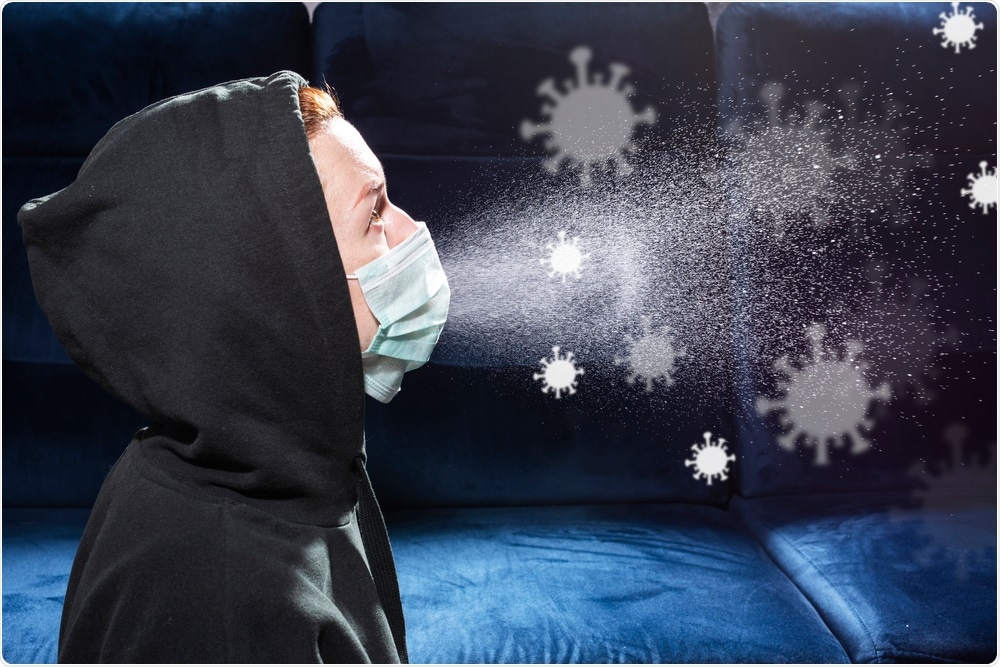The spread of SARS-CoV-2 is known to be through respiratory droplets as well as via aerosols, composed of minute particles normally exhaled during natural breathing.

Image Credit: Aliaksandra Post/Shutterstock.com
A recent study published in the preprint server medRxiv* in September 2020 reports some important findings on the variation in respiratory droplets between individuals, the change in this parameter over time, and with the clinical course of COVID-19.
Mucus Droplets in Respiratory Aerosols
Respiratory droplets in exhaled air are generated due to the velocity of airflow in the upper airway during breathing, talking, coughing, and sneezing. As air flows over the thin mucus layer lining the airways, the mucus breaks up into tiny droplets.
The exact limits of this phenomenon depend on the attributes of the mucus, such as its viscoelasticity and surface tension, as well as the type and concentration of lung surfactant.
Any change in mucus composition and structure will therefore reflect the condition of the individual, including the presence of COVID-19. The current study explored the effect of this infection, its severity, and the variation of breathing during various types of exhalation.
The 80:20 Super-Spreader Rule
Using 74 healthy volunteers to measure breathing on two days, they classified the subjects as those exhaling more or less than 240 particles per liter of air. Those in the first group made up a fifth of the group but accounted for four-fifths of the total particle production on the first day. This corresponds to the classic 80%:20% definition of super-spreaders in infectious disease spread.
Even within this 20%, only half of the individuals produced 80% of the total production in this group. That is, 7 individuals produced 64% of the total particles from the 74-member group. There were 60 low-producers. It should be noted that the numbers of exhaled particles vary with time and with the course of breathing in each person, and also concerning the total exhaled aerosol particles.
Aerosol Particles and Age/BMI
The aerosol particles failed to vary with sex but did show significant and proportional changes with age and body mass index (BMI). Those below 26 years of age exhaled fewer particles, as did those with BMI below 22.
Combining these measures as BMI-years, the researchers found that those with over 950 BMI-years have more exhaled particles than those with less than 950 BMI-years.
Viral RNA-Aerosol Particle Correlation
The researchers also looked at infection in two non-human primate models, the rhesus macaque and the African green monkey. After experimentally inducing SARS-CoV-2 infection by aerosols containing particles of about 2 µm size, mucosal swabs showed that productive infection was established in both models. The viral titer was positive by day 1, peaked on day 7 from infection, began to fall on day 14, and became undetectable by day 28.
Exhaled breath particles followed the same pattern, beginning to increase at day 3 through day 7, but returning to baseline levels by day 14, in all animals. However, the rhesus monkeys showed a higher increase in the number of particles. The viral genomic RNA titer and the number of aerosol particles were correlated in 75% and 50% of rhesus and African green monkeys, respectively.
Particle Distribution
The average particle distribution also changed with the course of the disease, from an increase in those <1 µm from day 3 onwards through day 7, and then partly returning to baseline by day 14.
The study shows, “That exhaled breath particles vary substantially between individuals in an uninfected human population and adhere to classical super spreading 20:80 rules, further suggests that the nature of COVIDCOVID-19 transmission, and super spreading, is not only a matter of air currents and proximity of infected and naive hosts but also of the human phenotype.”
Implications
In addition to confirming the presence of super-spreaders in COVID-19 transmission, the researchers also show that most people are at risk for the entry of SARS-CoV-2 deep into the lungs as well as being able to exhale it into the environment once their upper airway is exposed to the virus.
Nonetheless, the high risk of infection in environments like nursing homes can be traced to the presence of elderly “super-spreaders” in contact with caregivers and other staff, as well as with each other, for long periods.
Most of the respiratory droplets exhaled in all NHPs were comprised of small droplets at the peak of COVID-19 infection, showing the increased risk of infection at this time despite the use of traditional masks, and capable of transmitting the virus beyond the 2-meter limit of social distancing.
The researchers suggest that in addition to these measures, therefore, “approaches to stabilize airway lining mucus and retain mucus clearance function might be particularly useful.’ Moreover, the number of exhaled aerosol particles serves to indicate the clinical course of the disease, the risk to healthy individuals, and to monitor the spread of this and other infectious respiratory diseases.
*Important Notice
medRxiv publishes preliminary scientific reports that are not peer-reviewed and, therefore, should not be regarded as conclusive, guide clinical practice/health-related behavior, or treated as established information.
Journal reference:
-
Edwards, D. A. et al. (2020). Exhaled Aerosol Increases With COVID-19 Infection, And Risk Factors of Disease Symptom Severity. medRxiv preprint. doi: https://doi.org/10.1101/2020.09.30.20199828. https://www.medrxiv.org/content/10.1101/2020.09.30.20199828v1